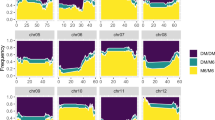Abstract
The genotypic variation of 1180 progeny from 118 genitors belonging to five taxa ofPennisetum sect.Brevivalvula has been estimated by isoenzyme electrophoresis with observations on five enzymatic systems, in order to compare the type of reproduction in polyploid and diploid taxa. A total of 112 different isozyme genotypes has been found, over all taxa. Genotypic variation was found among all progeny of the diploid populations ofP. polystachion andP. subangustum, as a consequence of their sexual reproduction system. At the polyploid level the type of reproduction appears to be predominantly agamic, but genotypic variation in the progeny was not rare: five tetraploid and one hexaploidP. pedicellatum, one pentaploid and one hexaploidP. polystachion and one hexaploidP. hordeoides, in a total of 90 genitors. Genetic relationships have been observed between the diploid sexualP. polystachion andP. subangustum, and, to a lesser extent, with the tetraploids of the same taxa as well. TetraploidP. polystachion andP. pedicellatum share genotypes with most other chromosomal taxa.
Similar content being viewed by others
References
Asker, S. E, Jerling, L., 1992: Apomixis in plants. — Florida: CRC Press.
Bashaw, E. C., Funk, C. R., 1987: Apomictic grasses. — InFehr, W. R., (Ed.): Principles of cultivar development: crop species,2, pp. 40–82. — New York: MacMillan.
Birari, S. P., 1981: Mechanism of apomixis inPennisetum polystachion Schult. — J. Maharashtra Agric. Univ. Coll. Agric.6: 208–221.
Brown, W. V., Emery, W. H. P., 1958: Apomixis in theGramineae: Panicoideae. — Amer. J. Bot.45: 253–263.
Brunken, J. N., 1979a: Cytotaxonomy and evolution inPennisetum sectionBrevivalvula (Gramineae) in tropical Africa. — Bot. J. Linn. Soc.79: 37–49.
, 1979b: Morphometric variation and the classification ofPennisetum sectionBrevivalvula (Gramineae) in tropical Africa. — Bot. J. Linn. Soc.79: 51–64.
Chatterji, A. K., Pillai, G. K., 1970: Apomixis inPennisetum pedicellatum. Trin. — Sci. & Cult.36: 667–669.
Clayton, W. D., 1972:Gramineae. 101.Pennisetum. — InHepper, F. N., (Ed.): Flora of West Tropical Africa,3, pp. 459–462. — London: Crown Agents.
De Wet, J. M. J., 1971: Polyploidy and evolution in plants. — Taxon20: 29–35.
, 1970:Bothriochloa intermedia — a taxonomic dilemma. — Taxon19: 339–340.
Dujardin, M., Hanna, W. W., 1983: Meiotic and reproductive behaviour of facultative apomictic BC1 offspring derived fromPennisetum americanum —P. orientale interspecific hybrids. — Crop Sci.23: 156–160.
, 1984: Microsporogenesis, reproductive behavior, and fertility in fivePennisetum species. — Theor. Appl. Genet.67: 197–201.
Greene, C. W., 1984: Sexual and apomictic reproduction inCalamagrostis (Gramineae) from eastern North America. — Amer. J. Bot.71: 285–293.
Greig-Smith, P., 1983: Quantitative plant ecology. Studies in ecology (9). 3rd edn. — Oxford: Blackwell.
Hanna, W. W., Bashaw, E. C., 1987: Apomixis: its identification and use in plant breeding. — Crop Sci.27: 1136–1139.
, 1982: Apomictic interspecific hybrids between pearl millet andPennisetum orientale. — Crop Sci.22: 857–859.
Harlan, J. R., Celarier, R. P., 1961: Apomixis and species formation in theBothriochloeae Keng. — Recent Advances Bot.1: 706–710.
, 1963: The compilospecies concept. — Evolution17: 497–501.
Jauhar, P. P., 1981: Cytogenetics and breeding of pearl millet and related species. — New York: Liss.
Kalyane, V. L., Chatterji, A. K., 1981: Reproductive characteristics ofPennisetum pedicellatum. — Indian J. Genet.41: 384–388.
Khosla, P. K., Mehra, P. N., 1973: IOPB chromosome number reports. XLI. — Taxon22: 650–651.
Lubbers, E. L., Arthur, L., Hanna, W. W., Ozias-Akins, P., 1994: Molecular markers shared by diverse apomicticPennisetum species. — Theor. Appl. Genet.89: 636–642.
Marshall, D. R., Brown, A. D. H., 1974: Estimation of the level of apomixis in plant populations. — Heredity32: 321–333.
McCullagh, P., Nelder, J. A., 1989: Generalized linear models. 2nd edn. — London: Chapman & Hall.
Partridge, I. J., 1975: The improvement of mission grass (Pennisetum polystachion) in Fiji by topdressing superphosphate and oversowing a legume (Macroptilium atropurpureum). — Trop. Grasslands9: 45–51.
Renno, J.-F., Schmelzer, G. H., De Jong, J. H., 1995: Variation and geographical distribution of ploidy levels inPennisetum sectionBrevivalvula (Poaceae) in Burkina Faso, Benin and southern Niger. — Pl. Syst. Evol.198: 89–100.
SAS Institute Inc., 1988: Procedures guide; 1989. SAS/STAT user guide; 1990. —Cary, N.C: SAS Institute.
Savidan, Y., 1982: Nature et hérédité de l'apomixie chezPanicum maximum Jacq. — Trav. Doc. O. R. S. T. O. M.153.
Schmelzer, G. H., 1997: Review ofPennisetum sectionBrevivalvula (Poaceae). — Euphytica97: 1–20.
, 1997: Genetic variation in the agamic species complex ofPennisetum sectionBrevivalvula (Poaceae) from West Africa: ploidy levels and isozyme polymorphism. — Euphytica96: 23–29.
Singh, L. N., Katoch, D. C., 1980: Genetic diversity inPennisetum species and their utilisation in meadows and pastures of hills. — InGupta, V. P., Minocha, J. L., (Eds): Trends in Genetical Research on Pennisetums, pp. 267–273. — Ludhiana: Punjab Agricultural University.
Skerman, P. J., Riveros, F., 1990: Tropical grasses. — F. A. O. Pl. Prod. Protect. Ser.23.
Stapf, O., Hubbard, C. E., 1934:Pennisetum. — InPrain, D., (Ed.): The flora of tropical Africa, pp. 954–1070. — Ashford: Reeve.
Wendel, J. F., Weeden, N. F., 1989: Visualisation and interpretation of plant isozymes. — InSoltis, D. E., Soltis, P. S., (Eds): Isozymes in plant biology, pp. 5–45. — London: Chapman & Hall.
Author information
Authors and Affiliations
Rights and permissions
About this article
Cite this article
Schmelzer, G.H., Renno, J.F. Genotypic variation in progeny of the agamic grass complexPennisetum sectionBrevivalvula in West Africa. Pl Syst Evol 215, 71–83 (1999). https://doi.org/10.1007/BF00984648
Received:
Revised:
Accepted:
Issue Date:
DOI: https://doi.org/10.1007/BF00984648




